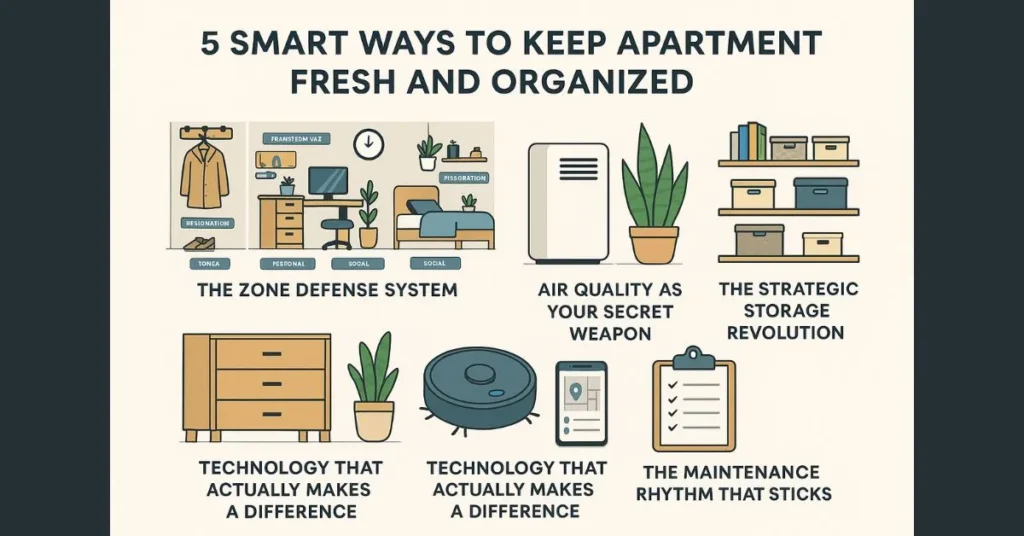Your apartment should be your sanctuary – a place where you can breathe easily, think clearly, and feel genuinely comfortable. Yet if you’re like most urban dwellers, you’ve probably experienced that frustrating cycle: you spend hours cleaning and organizing, only to have everything fall apart within days.
The problem isn’t your effort or motivation. It’s that most apartment organization advice treats symptoms rather than addressing root causes. The five strategies we’re about to explore aren’t just cleaning tips – they’re systematic approaches that work with apartment living realities rather than against them.
These methods have been tested in real-world urban environments and refined based on what actually works long-term. They’re designed for busy people who want lasting results, not temporary fixes.
Contents
- The Fresh Start Psychology – Why It Matters More Than You Think
- Smart Way #1 – The Zone Defense System
- Smart Way #2 – Air Quality as Your Secret Weapon
- Smart Way #3 – The Strategic Storage Revolution
- Smart Way #4 – Technology That Actually Makes a Difference
- Smart Way #5 – The Maintenance Rhythm That Sticks
- Putting It All Together – Your 30-Day Implementation Plan
The Fresh Start Psychology – Why It Matters More Than You Think
Before diving into specific strategies, let’s talk about why freshness and organization matter beyond just appearances.
Research shows that people spend approximately 90% of their time in different indoor environments, making indoor air quality and spatial organization crucial factors in daily well-being. Poor indoor air quality alone can reduce productivity by 6% to 9%, while cluttered spaces increase stress hormones and reduce cognitive function.
But here’s what’s particularly relevant for apartment dwellers: indoor air can be up to 5 times more polluted than outdoor air due to limited ventilation, shared building systems, and the concentration of pollutant sources in smaller spaces. This means that apartment freshness isn’t just about comfort – it’s about health and mental performance.
The psychology of organized spaces is equally compelling. Barbara Hemphill captured this perfectly when she observed that “clutter is nothing more than postponed decisions.” In apartments where every square foot matters, postponed decisions accumulate quickly and create cascading stress.
The five strategies that follow address both the physical and psychological aspects of apartment living, creating systems that maintain themselves rather than requiring constant intervention.
Smart Way #1 – The Zone Defense System
Forget room-by-room organization. In apartments, spaces often serve multiple functions, making traditional organizational approaches ineffective. Instead, think in terms of activity zones that can adapt to your living patterns.
Creating Functional Micro-Environments
The zone defense system divides your apartment into purpose-driven areas that maintain their own organizational rules and cleaning requirements.
The Transition Zone: This is the area immediately inside your entrance – crucial for apartments where you walk directly into living spaces. Create a dedicated drop zone with hooks for keys, a small table for mail, and a shoe storage solution. This zone prevents the daily influx of urban debris from spreading throughout your space.
The Work Zone: Whether it’s a corner desk or kitchen counter, your work area needs strict boundaries to prevent professional stress from contaminating relaxation spaces. All work materials should have designated homes within arm’s reach, and end-of-day protocols should completely clear the space for non-work activities.
The Restoration Zone: This is typically your bedroom and bathroom area, designed specifically for rest and recovery. Everything in this zone should promote calm and cleanliness – minimal visual clutter, good air circulation, and surfaces that stay consistently clear.
The Social Zone: Your living and dining areas optimized for both daily comfort and guest-readiness. Storage solutions in this zone should be attractive enough for open display while functional enough for quick organizing when company arrives.
The Maintenance Zone: Usually the kitchen and utility areas, optimized for efficiency and hygiene. These zones need the most systematic organization because they handle the daily input and output that keeps your apartment functioning.
Each zone has its own cleaning cadence and organizational requirements. Instead of trying to clean your entire apartment at once, you rotate through zones on different schedules based on their usage patterns and contamination rates.
Smart Way #2 – Air Quality as Your Secret Weapon
Most people think air freshness comes from cleaning products or air fresheners, but these often make indoor air quality worse. Real freshness comes from understanding and managing the sources of air contamination in apartments.
The EPA reports that apartments can have the same indoor air problems as single-family homes, plus additional challenges from shared ventilation systems and pollutants that move between units. But you can take control of your apartment’s air quality through strategic interventions.
Source Control: Identify and minimize pollution sources rather than trying to mask their effects. Common apartment air pollutants include cooking vapors, cleaning product chemicals, fabric softeners, and off-gassing from furniture and carpets. Switch to low-VOC products, ensure proper kitchen ventilation, and avoid synthetic fragrances.
Ventilation Optimization: Even in apartments with limited windows, you can improve air circulation. Use bathroom and kitchen exhaust fans strategically, create cross-breezes when possible, and never block air supply vents with furniture. If your apartment feels stuffy, the EPA suggests opening a window temporarily to increase ventilation, though this should be balanced against outdoor air quality concerns.
Natural Air Purification: While plants alone won’t solve air quality problems, certain varieties can contribute to cleaner air while adding life to your space. Focus on low-maintenance options like snake plants, pothos, or peace lilies that thrive in apartment conditions.
Strategic Air Movement: Use fans to prevent air stagnation and distribute clean air throughout your space. Ceiling fans should rotate counterclockwise in summer and clockwise in winter to optimize air circulation patterns.
The result is an apartment that feels consistently fresh without relying on temporary fixes or artificial scents that may compromise air quality.
Smart Way #3 – The Strategic Storage Revolution
Apartment storage challenges require thinking beyond traditional solutions. The key is creating storage systems that increase capacity while maintaining accessibility and visual appeal.
Vertical Integration: In apartments, wall space is often underutilized. Install floating shelves, wall-mounted hooks, and vertical organizers that draw the eye upward and make spaces feel larger while providing essential storage.
Multi-Functional Furniture: Every piece of furniture should serve at least two purposes. Ottoman storage, beds with built-in drawers, and dining tables with shelf space underneath maximize utility without cluttering your space.
The 80/20 Storage Rule: Store 80% of your belongings in closed, organized systems, leaving only 20% visible for daily use and aesthetic appeal. This prevents the visual overwhelm that makes apartments feel cluttered regardless of actual organization.
Rotation Systems: For items you don’t use daily but need periodically, create seasonal rotation systems. Store off-season clothing, holiday decorations, and occasional-use items in hard-to-reach places, rotating them as needed.
Emergency Access: Always maintain easy access to cleaning supplies, first aid items, and important documents. These shouldn’t be buried in storage systems but should have designated, easily accessible homes.
The goal is creating storage that adapts to your lifestyle rather than forcing you to adapt to your storage limitations.
Smart Way #4 – Technology That Actually Makes a Difference
The right technology can maintain apartment freshness and organization with minimal ongoing effort, but it’s important to choose solutions that integrate seamlessly into apartment living.
Air Quality Monitoring: Simple, affordable air quality monitors can alert you to problems before they become noticeable, allowing proactive rather than reactive management of your indoor environment.
Automated Cleaning: Robot vacuums designed for apartments can maintain baseline cleanliness between deeper cleaning sessions. Look for models that handle both hard floors and small rugs while navigating tight spaces effectively.
Smart Storage Solutions: Apps that help you track stored items, expiration dates, and maintenance schedules can prevent the accumulation problems that plague apartment living. Digital inventory systems are particularly useful for small spaces where you can’t see everything at once.
Environmental Controls: Smart thermostats, humidity monitors, and automated ventilation systems can maintain optimal indoor conditions without constant attention, particularly important in apartments where you may have limited control over building-wide systems.
Organization Apps: Digital tools that send reminders for routine maintenance, track cleaning supplies, and coordinate household tasks with roommates can prevent the small oversights that lead to larger problems.
The key is choosing technology that reduces your mental load rather than adding complexity to your routines.
Smart Way #5 – The Maintenance Rhythm That Sticks
The most elegant organizational systems fail without sustainable maintenance routines. Apartment living requires maintenance rhythms that work with urban schedules and energy levels.
The Daily Five: Identify five daily actions that prevent chaos accumulation: clear kitchen counters, make beds, handle mail immediately, return items to designated homes, and run the dishwasher or do dishes. These take less than 10 minutes total but prevent most organizational breakdowns.
Weekly Rotation: Instead of marathon weekend cleaning sessions, rotate through your zones on a weekly schedule. Monday might be Transition Zone day, Tuesday could focus on air quality and ventilation, and so on. This spreads workload and prevents any area from becoming overwhelming.
Monthly Deep Cycles: Once monthly, do intensive maintenance on systems that don’t need daily attention: organizing storage areas, deep cleaning appliances, rotating seasonal items, and assessing what’s working in your organizational systems.
Seasonal Adjustments: Urban apartments face different challenges across seasons – humidity changes, pollution levels, indoor/outdoor balance shifts. Adjust your maintenance routines seasonally rather than fighting against environmental changes.
Professional support can be integrated into these rhythms when needed. Services like reliable apartment cleaning services nyc can handle periodic deep cleaning that maintains your organizational systems without disrupting your daily routines.
Putting It All Together – Your 30-Day Implementation Plan
Benjamin Franklin observed that “for every minute spent organizing, an hour is earned.” This is particularly true in apartments where disorganization compounds quickly in limited spaces.
Week 1: Assessment and Zone Creation Document your current apartment challenges and establish your zone boundaries. Don’t try to organize yet – just observe how you actually use your space and identify zone-specific needs.
Week 2: Air Quality Foundation Address obvious air quality issues: improve ventilation, eliminate synthetic fragrances, and establish source control practices. This creates the fresh foundation that makes organization more pleasant and sustainable.
Week 3: Strategic Storage Implementation Tackle one storage challenge per day: vertical solutions, multi-functional furniture arrangement, or rotation system creation. Focus on systems that will have immediate impact on daily life.
Week 4: Technology and Maintenance Integration Add helpful technology solutions and establish maintenance rhythms that feel sustainable. Start with daily habits before adding weekly or monthly routines.
Month 2 and Beyond: Refinement and Adaptation Use the second month to refine systems based on what you’ve learned about your actual living patterns. Adjust zone boundaries, modify storage solutions, and fine-tune maintenance rhythms.
The goal isn’t perfection – it’s creating systems that maintain themselves with minimal effort while providing maximum benefit to your daily life.
Your apartment should enhance your urban lifestyle, not complicate it. These five smart approaches work together to create living spaces that stay fresh and organized naturally, supporting your goals rather than draining your energy.
Start with the strategy that addresses your biggest current frustration, then gradually integrate the others as the first becomes automatic. Small, consistent improvements compound into dramatic lifestyle changes when applied systematically over time.
Urban apartment living has unique challenges, but it also offers opportunities for efficient, intentional living that can be more satisfying than managing larger spaces. These five strategies help you capture those benefits while minimizing the downsides.
Your future self will thank you for building these systems now, when you have the mental energy to think them through properly. Once established, they’ll support you through busy periods, stressful times, and life changes that would otherwise derail less systematic approaches to apartment maintenance.

